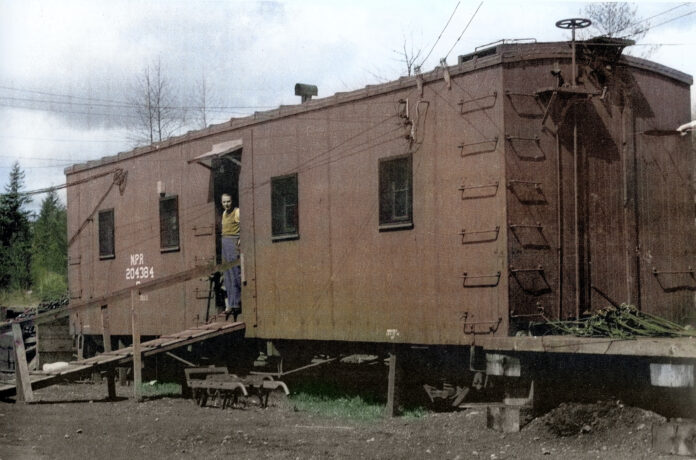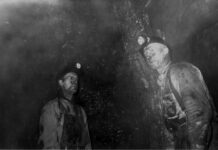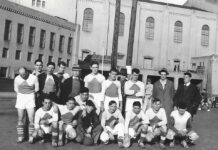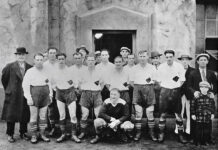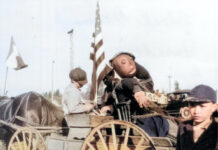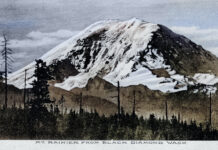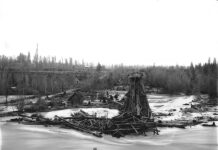Last week’s column detailed the origin of the Northern Pacific (N.P.) Railway’s transcontinental railroad that began near Duluth, Minnesota in 1870 and arrived at its western terminus in Tacoma three years later. Locally, the final connecting leg traveled down the Green River from Stampede Pass through Palmer on its way to Enumclaw, Buckley, and South Prairie in 1887. There it connected to an earlier branch railroad that served the Pierce County coal fields around Wilkeson and Carbonado.
A gorgeous Victorian-style railroad station was built in 1900 in Kanaskat when the Palmer Cut-off extended a new line through Ravensdale and Covington for a more direct connection to Auburn, conveniently located halfway between Tacoma and Seattle. That two-story depot burned to the ground on Dec. 30, 1943, after the night telegraph operator, Gordon Trahanes filled the coal stove, opened the draft and damper, and fell asleep. N.P. needed a new station but it was during the darkest days of World War II, when much of America’s industrial might was fully engaged in a two-front fight.
A simple solution was quickly devised. N.P. converted an ‘outfit’ car to become this temporary depot to house the station agent and serve passengers on the daily trains that traveled between Seattle and Spokane until 1970. ‘Outfit’ is the railroad term for a gang of laborers, in those days almost exclusively men, who worked in teams to replace wooden ties and rails in a near-constant battle to maintain the tracks. Just as today’s roads and highways develop potholes and need periodic repairs, so does a railroad that carries far heavier loads of commodities such as grain, coal, lumber, and petroleum.
The outfit rail cars were traveling living quarters with bunk beds, a small kitchen, a sink, and showers. At Kanaskat in early 1944, outfit car number 204384 was converted to a rail depot with a table, desk, office equipment, telegraph, and various train order signal apparatus. The station agent, sometimes called the ‘day man’ was in charge of the depot. He was also the telegraph operator and often referred to as the Agent-Telegraher. If the station was busy enough to require multiple telegraph operators, there would be three shifts a day, called ‘tricks’ in rail parlance. The first trick was the day shift, the afternoon shift from 4 p.m. to midnight termed the second trick, and the final third from midnight to 8 a.m. was the third trick, though many depots were closed overnight.
Ruth (Trueblood) Eckes, a 17-year-old at the time relates her first ‘solo’ job for N.P. was at Kanaskat, just after the depot burned down. “The railroad moved in an outfit car. Half of it was the telegraph office and the other half the waiting room.
“My living quarters were not much better. The only housing available was a one-room cabin in the woods located about a mile from the depot. The inside of the cabin was ‘make do’ with a couple of cupboards on the wall for supplies … an old wood and coal range for heat and cooking.
“The back door led into a wood shed containing fuel for the stove. My bathtub was a big washtub hanging on a nail. Any hot water for dishes or taking a bath had to be heated in pots and pans on the stove. The outhouse was behind the cabin under a tree. Trips after dark required a flashlight in order to find it. The house did have electric lights—one light globe in the ceiling.
“Being alone in the depot each night was a little terrifying and responsibility hung heavy. The deputy sheriff from Enumclaw kept an eye on me though.”
In this photo by Jim Fredrickson from his book, “Railroad Shutterbug,” agent Stanley Edwall is standing in the doorway. Edwall was a respected railroad man, and according to his friend, Dave Sprau, “neat and clean, very friendly and helpful, and was plain as an old shoe.” Stan was also the local ‘union-griever’ a term for the shop steward who presents employee grievances to management.
Edwall belonged to the Order of Railroad Telegraphers, one of a dozen railroad workers’ unions organized along craft lines. There were unions for conductors, engineers, roundhouse workers, track layers, signal maintenance personnel, and even clerical workers. Stan Edwall left the Kanaskat depot circa 1955 when he became the station agent in Kent, where he retired.
As mentioned in last week’s column, Kanaskat had the distinction of being home to four rail stations in a span of 60 years. Next week’s column will highlight the third depot built in 1946 that replaced this round-roofed former outfit car.
Many of the details reported herein were provided by Dave Sprau who joined Northern Pacific on May 28, 1960 at age 16 as a night telegraph operator in their Easton station. He learned those skills during high school thanks to the helpfulness of Great Northern Railway telegraphers in Monroe, his hometown. Sprau ended his 40-year career in 2000 with N.P.’s successor Burlington Northern Santa Fe. Today, BNSF is owned by Berkshire Hathaway, whose founder and longtime CEO, Warren Buffett recently announced his retirement. Photo colorization was created by Boomer Burnham, a Tahoma photography instructor doing business as http://www.boomersphotography.com/

